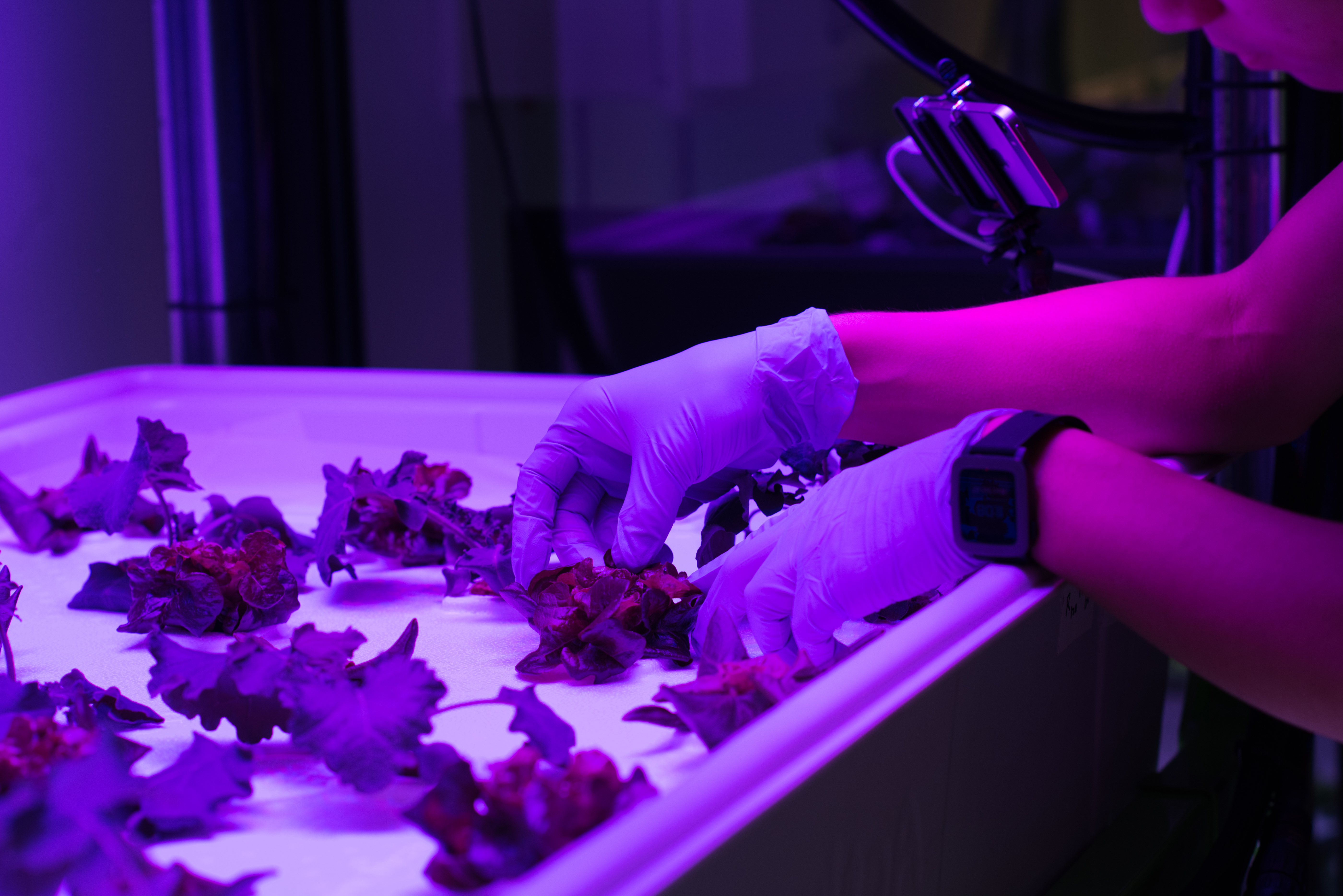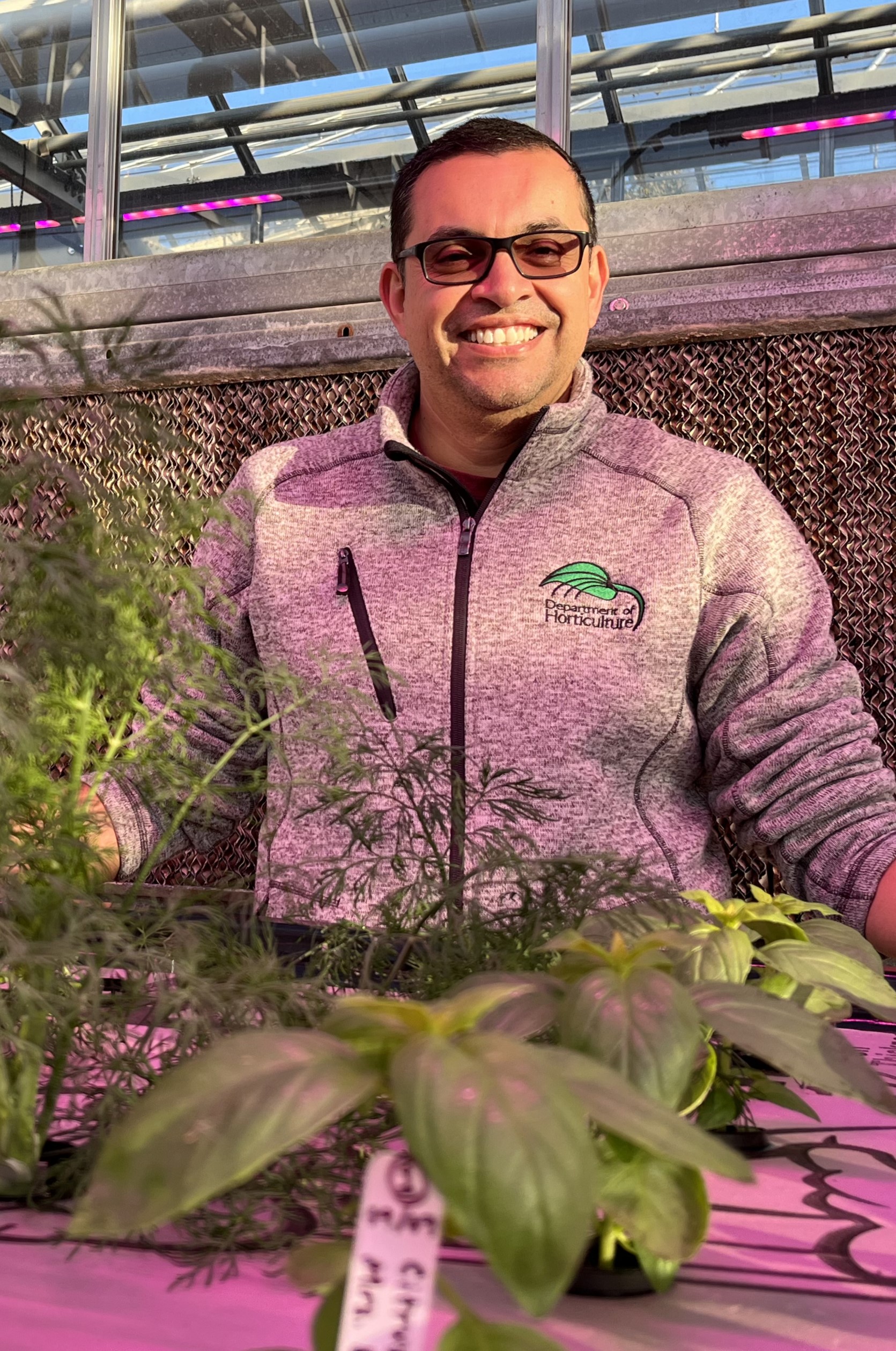Controlled-environment agriculture research sees innovation through Project GREEEN
MSU researchers have used Project GREEEN funding to optimize greenhouse production for more than 25 years.
EAST LANSING, Mich. — Michigan’s greenhouse industry is one of the largest in the country with an economic impact of more than $740 million annually. According to the Michigan Greenhouse Growers Council, the industry employs more than 9,000 people and ranks third in the U.S. with 47.9 million square feet under cover.
Throughout Project GREEEN’s 25 years, the program has supported research on controlled-environment agriculture and how to increase its economic viability.
Erik Runkle, a professor and Extension specialist in the Michigan State University Department of Horticulture, joined the faculty in 2001 and has utilized Project GREEEN funding for the entirety of his tenure. His research program focuses on the environmental physiology of herbaceous specialty plants grown in controlled environments.

Some of his earliest work was aimed at determining the environmental factors that influence flowering in potted orchid plants. Orchids are some of the most popular floricultural plants in the world, admired for their beautiful appearance, long lifespan and the relative ease of caring for them.
Runkle and his team found that altering environmental aspects such as temperature can cause some types of orchids to flower at different times. For example, exposing plants to specific temperature regimens can delay flowering until demand is highest at times such as Valentine’s Day or Mother’s Day.
“This was really foundational work to understand how these environmental factors influence flowering that would not have been possible without Project GREEEN,” Runkle said. “We’ve been partnering with greenhouse growers and delivering information to them, as well as hobbyists and anyone interested in growing these plants, for many years. My roles in research and outreach through MSU Extension pair well with Project GREEEN’s model, and we’ve been able to leverage that funding to expand our research program.”
In the mid-2000s, Runkle received multiple Project GREEEN grants to explore improving energy efficiency in greenhouse production. Because most floricultural crops are produced in Michigan from January to May, significant energy is required to heat greenhouses. When energy prices are high, it cuts into the grower’s bottom line.
In response to soaring energy prices in 2007 and 2008 prior to the global economic crisis, many growers were lowering the temperature of their greenhouses to save money. While it may seem like a logical step, Runkle said it was apparent there would be unintended consequences.

Runkle’s team conducted a feasibility study to identify strategies that growers could use to decrease energy consumption, in addition to generating species-specific information on the influence of temperature and daily light integral on more than 30 common annual bedding plants.
“Lowering temperatures elongates the growth process, so we hypothesized that energy expenditure may actually increase because plants occupy greenhouse space for a longer time,” Runkle said. “Our research showed that in many circumstances, that indeed occurred. We developed a series of resources for growers on how to save energy while also producing high-quality crops.”
More recently, Runkle has investigated the effects of lighting on the production of premium-quality specialty food products — leafy greens such as kale, lettuce and spinach.
Alongside a team of researchers including Roberto Lopez, an associate professor and Extension specialist in the MSU Department of Horticulture, Runkle used Project GREEEN funding to examine how light color and intensity interact to affect yield and quality. The team also looked at consumer attributes such as taste and texture to monitor the effects of lighting, and worked to create educational materials for distribution to growers.
The project was enhanced by the completion of the Controlled-Environment Lighting Laboratory on campus, which houses research with various types of light-emitting diode (LED) lighting.
Researchers found that far-red light increases leaf size and allows plants to capture more light, which leads to greater yield. It also decreased pigmentation in leaves and could lead to a lower-quality product. Conversely, blue light resulted in smaller, darker leaves with potentially greater quality attributes. Effects of green light were contextual with respect to other types of light that were present.
“We know there are many benefits to indoor controlled-environment agriculture, such as the significant reduction in water use, potential elimination of pesticides, uniform and consistent crops, and year-round production,” Lopez said. “But there are very real challenges, including high energy costs and other economic challenges such as high startup costs. We began to explore some of these with Project GREEEN funding and continue to look at ways to reduce production costs today with federal dollars.”
Preliminary results from this work led to a $2.7 million grant from the U.S. Department of Agriculture’s Specialty Crop Research Initiative (SCRI). Industry partners matched the funding, bringing the total to $5.4 million. The project, known as OptimIA (Optimizing Indoor Agriculture), has three major goals:
- Define optimal profitability based on yield and other high-value attributes of the plants, such as nutritional content.
- Optimize indoor environmental conditions, such as humidity, air movement, temperature, light and carbon dioxide concentration, to increase yield and high-value attributes.
- Encourage indoor farming stakeholders to collaborate with academic and industry groups that are working in controlled-environment agriculture.
Scientists on the project include Runkle, Lopez, Simone Valle de Souza — an assistant professor in the MSU Department of Horticulture — Chieri Kubota at Ohio State University, Cary Mitchell at Purdue University, and Murat Kacira at the University of Arizona.
Several findings have been made thus far, including that using mostly red light from seed to harvest maximized yield. This created some difficulties with seedling handling for transplanting, but that can be mitigated through the controlled use of blue light.

“What we’re seeing is that to achieve the desired plant characteristics, it takes some fine tuning with light across the spectrum,” Runkle said. “With recent advances in automated robotics for indoor vertical farming, moving plants to different spectrum zones has become feasible to achieve desired crop characteristics during each growth phase.”
Building on Project GREEEN research, SCRI also funded a $3.4 million project led by Lopez to explore the potential of expanding U.S. greenhouse production of fresh culinary herbs for a project called Controlled-Environment Agriculture (CEA) HERB.
Lopez is joined by Runkle, Bridget Behe — a professor emeritus in the MSU Department of Horticulture — Mary Hausbeck — a University Distinguished Professor in the MSU Department of Plant, Soil and Microbial Sciences — and scientists from Iowa State University, North Carolina State University, Texas Tech University, the University of Tennessee, and the U.S. Department of Agriculture’s Agricultural Research Service.
The team is conducting a survey to determine current production methods, sensory experiences and marketing strategies needed to expand the U.S. controlled-environment culinary herb industry. Researchers are also performing controlled-environment studies to identify practices that increase growth, quality, shelf-life, disease management and food safety. Finally, research outcomes will be used to create outreach materials for growers.
Lopez said that findings thus far include the effects of ultraviolet A (UVA) light on the height of fresh culinary herb plants, particularly basil. Producers have found that basil growing too quickly presents challenges with shipping, offering less room in containers and ultimately reducing revenue.
Chemical growth regulators are not used on plants that will be consumed, so Lopez and his team have shown that providing six hours of UVA light to basil plants at night significantly stunts growth. Lopez said this can result in a lighter-green plant, which may not be ideal, but exposing them to sunlight after UVA light eliminates this problem.
“This project is going to provide a lot of information about both the viability of controlled-environment U.S. fresh culinary herb production and the customers who are willing to pay a premium price for them,” Lopez said. “We must learn all we can about customers, which can then help us identify new markets and understand the demand for U.S.-grown products. It’s important that this project is a holistic research and outreach effort.”
Scott Stiles, general manager of Henry Mast Greenhouses in Byron Center, Michigan, has worked with Runkle and Lopez for nearly two decades. He has written several letters of support on their behalf for funding opportunities, including with Project GREEEN. He believes their efforts are vitally important to Michigan’s greenhouse industry.
“I can’t say enough good things about them, and the information they collect through their research is implemented in our operation regularly,” Stiles said. “Most recently, they’ve helped us with using LED lights to grow and propagate tropical plants such as Dipladenia and indoor houseplants, crops that are not something we’ve typically grown in the north but have gotten into in the last few years. We’re big supporters of MSU research through our business and continue to rely on it to advance our growing strategies.”
Michigan State University AgBioResearch scientists discover dynamic solutions for food systems and the environment. More than 300 MSU faculty conduct leading-edge research on a variety of topics, from health and climate to agriculture and natural resources. Originally formed in 1888 as the Michigan Agricultural Experiment Station, MSU AgBioResearch oversees numerous on-campus research facilities, as well as 15 outlying centers throughout Michigan. To learn more, visit agbioresearch.msu.edu.



 Print
Print Email
Email





